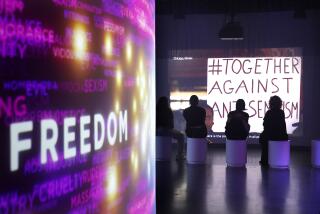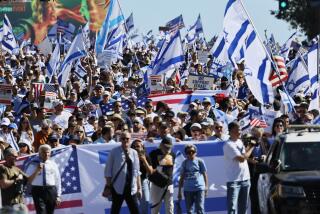Zoot Suit Riots: After 75 years, L.A. looks back on a violent summer
The lights flickered on inside the California Theatre and a band of sailors tore up and down the aisles yanking young people from their seats by the lapels of their suit jackets.
Inside the Spanish-language theater in downtown Los Angeles, the terrified crowd watched as uniformed men dragged people outside, beat them and stripped them down to their underwear.
It was June of 1943 — the start of the Zoot Suit Riots — and Victor Silva was 12 years old. He’s 87 now but still clearly remembers what if felt like to sit in that theater. He can still feel the fear of watching a truck full of men in uniform barrel down 1st Street, searching for their next victim. The police didn’t seem to care, Silva noticed. Sometimes a black-and-white cruiser drove in front of sailors, as if to escort them.
“It hit me right in the head at that moment,” recalled Silva, of Hermosa Beach. “They could do whatever they wanted.”
The notorious riots lasted 10 days and carry the name of the targeted victims — young people dressed in wide trousers pegged at the ankle and long coats — but the violent rampage was led by sailors, soldiers and Marines.
In the 1940s, Los Angeles, like the country itself, was in the middle of a dramatic shift spurred by World War II, said Eduardo Pagán, a history professor at Arizona State University. Many young men went to war, creating a hole in the workforce that led to more women and people of color getting factory jobs. The new dynamic sparked hysteria over who would keep a watchful eye over the children now that many mothers worked outside of the home, said Pagán, who wrote a book about the riots.
“The war creates a social anxiety,” he said. “That’s the background to the riot.”
Racial segregation was also a powerful force in L.A., Pagán said, adding that while researching his book he tracked down about 80 police reports from the 1940s in which people called the cops on so-called zoot suiters. The young people hadn’t actually broken any laws, Pagán said, but instead had done things such as refusing to cede a sidewalk to a white person. During that era, the professor said, many young people in Los Angeles were inspired by the art of jazz — by the spirit of defiance against segregation — and they adopted the signature clothing style. Soon, he said, people fixated on the zoot suit as a sign of criminality, and any young person — not only Mexican Americans — caught wearing ‘the drape,” as the outfit was often called, was forced to strip and attacked if they refused.
Though the general context is clear, history has never quite settled on the exact events that preceded the riots that first week of June. Some said it stemmed from an attack on military employees allegedly orchestrated by Mexican American gang members known at the time as pachucos. Others insisted it was an effort by Los Angeles police to distract people from the trial of a fellow officer. One thing is clear: Racist newspaper reports, including many in the Los Angeles Times, viewed the victims, not the military men, as the problem.
On June 7, 1943, The Times printed a lengthy article saying that young people in zoot suits seemed to be avoiding the streets at night. The opening paragraph read, “Those gamin dandies, the zoot suiters, having learned a great moral lesson from servicemen, mostly sailors, who took over their instruction three days ago, are staying home nights.”
Later in the month, The Times ran a brief about a news conference at which First Lady Eleanor Roosevelt said the riots had roots in long-standing discrimination. “For a long time,” she said, “I’ve worried about the attitude toward Mexicans in California and the states along the border.”
That discrimination was on full display during a notorious Los Angeles trial in the months before the riots.
The Sleepy Lagoon Trial, which stemmed from the slaying of a young Latino man near a reservoir in southeast L.A., led to one of the largest mass trials in state history. Twenty-two defendants were charged en masse in a case that historians now view as a shameful chapter in the history of Los Angeles County’s court system. At trial, a sheriff’s captain testified that “the Mexican element” had an innate “desire to use a knife or some lethal weapon. In other words, his desire is to kill, or, at least, let blood.”
For Silva, the 75th anniversary of the riots takes him back to his second-story bedroom in the Ramona Gardens housing project in Boyle Heights. He remembers clutching a bat, terrified that the sailors would come inside. His older brother was a pachuco, he said, and he assumed that the police had told the sailors which homes to target.
One night, Silva couldn’t sleep. It was almost 11:30 and his brother still wasn’t home.
“We were afraid the sailors were going to get him,” Silva said. Moments later, he heard clicking along the pavement — the telltale sound of his brother running home in his dress shoes. He was safe.
Over the years, as he studied the riots, Silva discovered a painful irony: While some young Mexican American men were being beaten and humiliated on the streets of Los Angeles, others were defending the U.S. at war.
On his 80th birthday, Silva and his grandchildren filled two cars and headed to Ramona Gardens. He showed them the building he’d lived in and told them about the truck full of sailors.
Their lives had been different than his, he told them, but they needed to know the history.
For more news from the Los Angeles County courts, follow me on Twitter: @marisagerber
More to Read
Start your day right
Sign up for Essential California for news, features and recommendations from the L.A. Times and beyond in your inbox six days a week.
You may occasionally receive promotional content from the Los Angeles Times.







